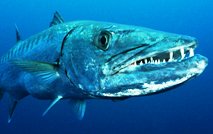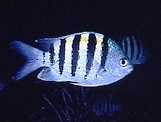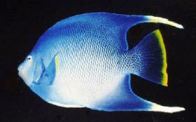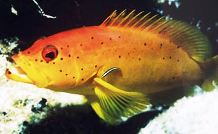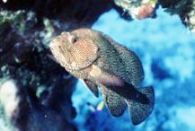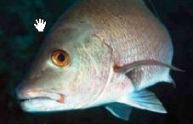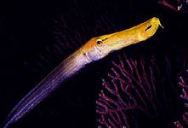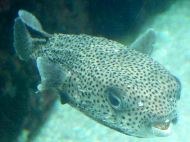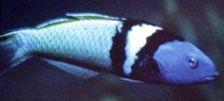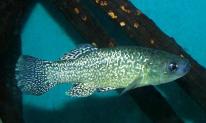Bermuda's Fish
There are different species of fish that you can see in Bermuda waters. Some can be seen near the reefs and are called reef fish, while some can also be seen close to the edges of the shore and in ponds. For the anglers, there are more than 27 different types of game fish in the waters surrounding Bermuda. Your best chance to see them is during
Deep Sea Fishing or
Reef Fishing. Although the scuba divers have an added advantage, even snorkelers can see a lot of Bermuda's fishes.
Here are some of the most common fishes of Bermuda:
Barracuda
A reef fish so named because of their fierce looking razor sharp teeth. They have the habit of opening and closing the mouth. Barracuda is a predator and their preys include snappers, grunts, wrasses and other types of fish.
They seem to be very inquisitive in nature and tend to follow a diver, but would disappear in a flash. Barracuda's attacks on humans are very rare. Flash light or flashy substances like metals are known to attract them.
Sergeant Major
They are so named because of the black stripes on their silver yellowish body. They are usually found near the reefs in mid water and often seen in groups. You will hardly find them in singles. They eat plankton and other floating organisms.
Blue Angel Fish
One of the most beautiful fish of the reefs. They have a blue hue. The juveniles are far darker having bright blue stripes running vertically along their bodies. They can grow up to 1-foot long. They apparently behave like angels as they mate for life.
Cleaner Wrasse
They are so named because they set up cleaning stations for other fishes. Other large fishes queue up, await their turn and get cleaned up of parasites by these wrasses. Sometimes the cleaning wrass would enter through the mouth of the large fish and clean up, and the large fish would do nothing.
These wrasses are bright and colorful making their presence prominent in the water.
Parrot Fish
They feed on plants on the underwater reefs. Their beak like mouth and the teeth are so designed that they can easily scalp algae and small plantations out of the reef's surface. They also have an interesting mating life. The mating male fish moves in a herd of female Parrot fish.
If the male dies, the largest female changes itself to a male. In other occasions, another non-mating male becomes a mating male. Parrot fish comes in different sizes and colors, but they all have a unique characteristic shape.
Groupers
As the name suggests, they need to group in large numbers in order to reproduce. But this behavior results in the groupers falling easy prey to the fishermen and thus reducing their number significantly. They are predators feeding on invertebrates and other fishes.
They hunt during the day time. Groupers can grow quite large in size weighing several hundred pounds and can live for several decades. The Black Groupers are locally know in Bermuda as Rock Fish.
Snappers
This fish likes to hide in the crevices of the reefs during the day time. They are carnivores and hunt during the night time. The picture on the left is of a Grey Snapper. There are other varieties as well.
Moray Eels
They are strange looking fish found hiding in the reefs during the day time. They don't have fins or scales like the usual fish, rather have a smooth body. They come out in the dark to hunt for preys. They have the habit of opening and closing their mouths which is the way they move water past the grills to breathe.
Trumpet Fish
A long fish looking like a trumpet. They come in many colors. Often you can find them hanging vertically with their head down near the sea fans and almost motionless, while drifting back and forth as the waves pass by.
Pufferfish
This strange fish can inhale air and water until it becomes completely spherical. Some also have sharp spines around their body. These defense mechanisms make it quite safe from predators since the one who eats it will not make the mistake again. They stay behind reefs during the day time and come out at dark to hunt on sea urchins, crabs, mollusks etc. from the coral reefs.
Blue Head Wrasse
Has a blue colored head. They can be found in large groups near the reefs. The adults have dark and white alternate stripes on the body. They are carnivores and eat invertebrates.
Bermuda Killifish
This is an endemic fish and found only in Bermuda. The males are smaller than the females. Average size is about 6cm. They live in both fresh and salt water ponds and feed on small plants, shrimps and insects. Female killifish lay eggs over several days and babies hatch after few weeks.
They go on to live for many years. You can find a lot of Killifish in Mangrove Lake in Hamilton parish, a pond measuring 30 acres.
Update December 2013: Two other types of fish - The Collette’s half beak and the Yellowfin Chromis have been recently recognized by Smithsonian Institute as endemic to Bermuda which means that they are unique to Bermuda waters.
Related Articles
2. Check out
Bermuda Coral Reefs to know all about the coral reefs of Bermuda and what kind of fish that you can expect to see there. The best reefs for fishing are on the south-western and north-western waters of Bermuda.
